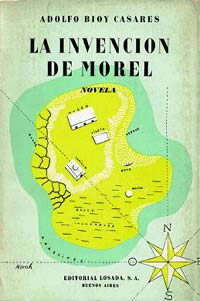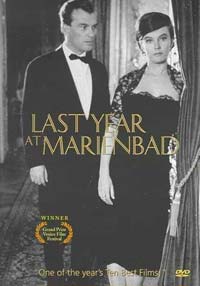 |
|
 |
|
nº 48 - Marzo 2004 • ISSN: 1578-8644 |
 |
|
|
 |
|
|
 |
"La fascinación de una trama perfecta"
philip jenkins |
|
 |
|
|
|
|
| english version |
Enlaces y contrastes entre La invención de Morel y El año pasado en Marienbad
No hay muchos libros en cuyos prólogos Jorge Luis Borges declarara que la trama de la novela que el lector va a encontrar es perfecta. Tal libro es La invención de Morel, publicada en Buenos Aires en 1940 por la Editorial Losada. Novela importante, admirada por Borges, Cortázar y Octavio Paz. La traducción al francés de 1953 inspiró la película de culto El año pasado en Marienbad (Francia, 1961) de Alain Resnais y Alain Robbe-Grillet. Ahora en los Estados Unidos y en el Reino Unido se edita de nuevo la traducción de Ruth Simms, revisada por Suzanne Jill Levine (New York Review Books, distribuida en el Reino Unido por Granta Books, £7.99).
En su prólogo Borges refiere a las peripecias de los libros con un intrínseco rigor. Lo mismo se puede decir de las novelas fantásticas como La isla del Doctor Moreau, publicada en 1896, una especie de modelo del libro de Bioy Casares. La narrativa de H.G. Wells se presenta en un manuscrito que cuenta la historia de una visita a una isla aislada, frecuentada por seres curiosos, características que aparecen en La invención de Morel, cuyo título (como escribe Borges) alude al inventor isleño precedente.
La novela tiene lo esencial de un clásico: una vez que acaba su lectura, el lector desea empezar de nuevo por el principio. Se dice que la novela de Bioy Casares se basa en la fascinación del autor por la actriz Louise Brooks, pues es ante todo un homenaje al cine. El protagonista descubre un grupo de personas alrededor de la figura del inventor Morel en la isla, un grupo de veraneantes que disfruta del sol en buena compañía. Con tiempo se entiende que en lugar de esas personas vivas se muestra una proyección de ellas, donde se repiten encuentros y diálogos, proyectados por máquinas inventadas por Morel. El protagonista anónimo de la novela se enamora de una mujer a quien le atribuye el nombre de Faustine (eco consciente del Fausto de la literatura alemana), objeto de interés también del mismo Morel. Incapaz de dialogar con la proyección de la mujer, el narrador se entromete físicamente en la trama del grupo con consecuencias imprevisibles también para él.
Es fácil creerque la novela habría podido inspirar a la película El año pasado en Marienbad. En la tercera página de la novela aparece la ciudad de Marienbad, el nombre alemán del centro vacacional aristocrático checo, aunque el narrador cree que el grupo de Morel sea francés. Hay ecos de la novela en la película, en los diálogos circulares, en la repetición de un juego de cerillas, y los pasillos eternos del palacio barroco que nos lleva a pensar en el museo del librito de Bioy Casares.
La trama de la película se ocupa de tres personas: dos hombres, "X" (representado por Giorgio Albertazzi), "M" (Sacha Pitoeff) y una mujer "A" (Delphine Seyrig). Así se replica al triángulo, narrador-Morel-Faustine. Hay un grupo de veraneantes anónimos a su alrededor. El sueño eterno del traje de etiqueta presenta un cuadro elegante, pero algo severo, de algunas personas hipnotizadas, como las proyectadas de la isla. "X" encuentra a "A", que tiene el peinado característico de Louise Brooks, y quiere convencerla de que se conocieron un año antes,, aunque la mujer insiste en que no se acuerda del encuentro. A pesar de la actitud posesiva de "M", la película termina con la intención aparente de que "A" y "X" se marchan, pero probablemente esta huida es otra imagen de la ambigüedad que sustenta toda la obra.
La novela consiste en la colisión de los dos narrativas, la del narrador y la del grupo de Morel. La película consiste a su vez en una narrativa que contiene la colisión de dos caracteres principales, con versiones diferentes de la realidad. La intención de la ficción cinematográfica es crear un enigma de la subjetividad que influirá en el cine de Europa en los años sesenta y setenta. Y la película también tiene lo esencial de un clásico: acaba el espectador de verla, y le gustaría verla de nuevo por el principio.
The Fascination of a Perfect Plot
Connections and contrasts between The Invention of Morel and Last Year at Marienbad
There cannot be many books with a prologue by Jorge Luis Borges which declares that the plot of the novel which the reader is about to encounter is a perfect one. The Invention of Morel, published in Buenos Aires in 1940 by Editorial Losada, is just such a book. An important novel for the literature of Latin America, admired by Borges, Cortázar and Octavio Paz, the French translation of 1953 inspired the film Last Year at Marienbad (France, 1961) by Alan Resnais and Alain Robbe-Grillet. The translation by Ruth Simms, revised by Suzanne Jill Levine, has been republished recently in the United States and in the United Kingdom (New York Review Books, distributed in the United Kingdom by Granta Books, £7.99).
In his important prologue Borges refers to adventure stories as books with an intrinsic rigour. The same can be said of fantastic novels such as The Island of Doctor Moreau, published in 1896, a kind of model for Bioy Casares's book. H.G. Wells's narrative is presented as a manuscript which tells the story of a visit to an isolated island inhabited by peculiar beings, characteristics of The Invention of Morel, the title of which (as Borges writes) alludes to the earlier island inventor.
The novel has the essential quality of a classic: once the reader has finished it he wants to start reading it again from the beginning. It is said that Bioy Casares's novel was based on the author's fascination with the actress Louise Brooks and it is possible to advance the theory that the novel is a homage to cinema. The protagonist discovers a group of people around the figure of the inventor Morel on an island, a group of holidaymakers who are enjoying the sun and their own company. Gradually the narrator comes to realize that in place of real people he is actually encountering a projection of them in which encounters and dialogues are repeated, everything projected by machines which have been invented by Morel. The anonymous protagonist of the novel falls in love with a woman to whom he gives the name Faustine (a conscious echo of the Faust of German literature), who is also an object of interest for Morel himself. Unable to enter into a dialogue with the projection of the woman, the narrator allows himself to be interpolated physically into the actions of the group with fatal consequences for him. Is this then a metaphor for the conquest of life by an obsession with figures of the imagination, be they of the cinema or of art?
It is very easy to understand how the novel could have inspired the film Last Year at Marienbad. The name of the city of Marienbad, the German name for the Czech aristocratic holiday resort, occurs on the third page, and Morel's group appears to the narrator to be French. There are echoes of the novel in the film in the circular dialogues of the characters, in the repetition of a game of matches which the character "M" always wins and in the eternal corridors of the baroque palace which is reminiscent of the museum in the book by Bioy Casares.
The plot of the film is concerned with three people: two men, "X" (played by Giorgio Albertazzi), "M"(played by Sacha Pitoeff) and a woman "A" (played by Delphine Seyrig. This replicates the triangle of the narrator-Morel-Faustine. They are also surrounded by a group of more anonymous holidaymakers. The eternal dream of evening dress that they represent is an elegant but severe picture of people who are almost hypnotized, like those projected on the island. "X" meets "A", who has the characteristic hairstyle of Louise Brooks, and seeks to convince her that they met a year before and that she promised him that she would leave with him one year after the original meeting, although the woman claims not to remember this. Despite the possessiveness of "M" the film ends with "A" and "X"apparently intending to leave, but this is probably another image of ambiguity.
If the novel consists of a collision of two narratives, that of the narrator and that of Morel's group, the film consists of one narrative which contains the collision of two principal characters who have different versions of reality. The intention behind the cinematographic fiction is to create an enigma of subjectivity that was to influence the cinema of Europe in the 1960s and the 1970s. And the film also has the essential quality of a classic: once you have watched it, you want to watch it all over again from the beginning.
|
|
|
|
|
|
|
|
 |




